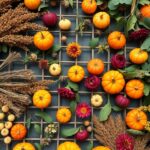Forest gardens are a fantastic way to bring nature into your backyard, combining beauty with sustainability. Here are 15 creative ideas to inspire your own garden space, showcasing a blend of edible and ornamental plants that thrive in harmony. Whether you’re a novice gardener or a seasoned green thumb, there’s plenty to spark your imagination!
Nutrient-Rich Composting Areas
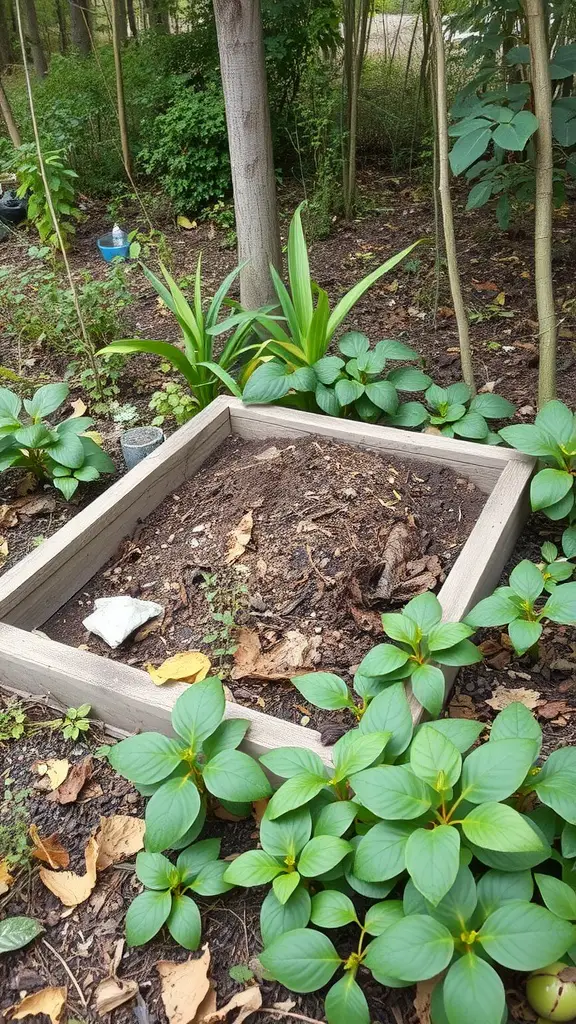
Creating a composting area in your forest garden is a fantastic way to recycle kitchen scraps and yard waste. This small, framed compost bin shown here is a great option. It’s neat and organized, making it easy to manage your composting process.
Surrounded by lush green plants, this compost area can be a perfect addition to your garden. The rich, dark soil inside is full of nutrients, ready to feed your plants once it breaks down. Adding things like vegetable peels, coffee grounds, and leaves will help create a vibrant compost pile.
Keep it balanced by adding both greens and browns. Greens are your kitchen scraps, while browns include dry leaves and cardboard. This balance creates an ideal environment for healthy microbes to do their work.
Don’t forget to turn your compost regularly! This helps aerate the pile and speeds up the decomposition process. In no time, you’ll have a nutrient-rich addition to your soil. It’s an easy way to give back to your garden.
Natural Water Features
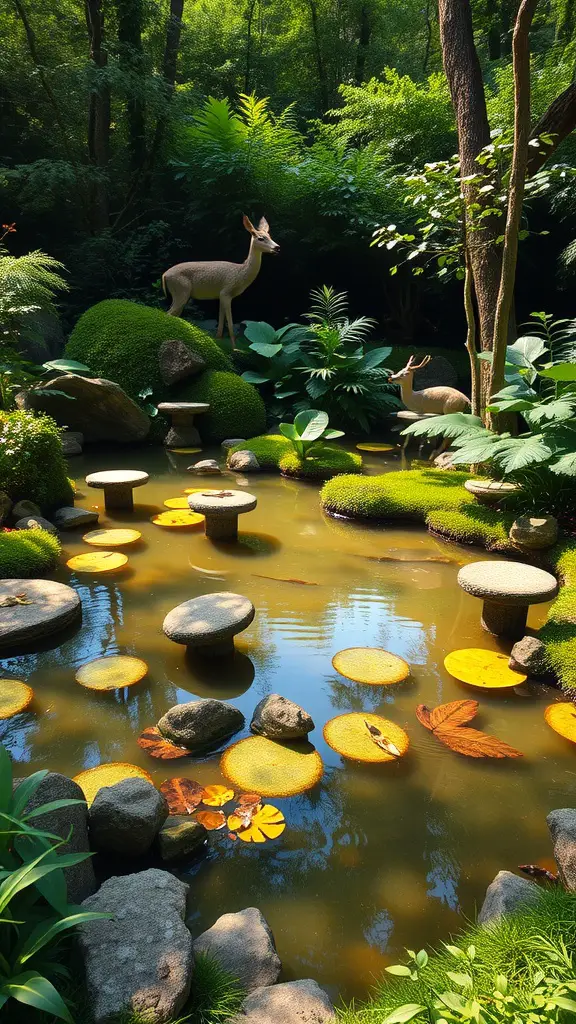
Water features can completely transform a garden. They add a sense of relaxation and beauty that draws you in. The image showcases a serene pond surrounded by lush greenery and playful stone elements.
Look closely at the pond; it has floating lily pads and round stones that add texture and interest. The gentle presence of water creates a peaceful atmosphere. Imagine sitting by this pond, hearing the soft sounds of water and enjoying the natural beauty.
Additionally, the setting includes artistic touches, like the deer figures, which blend seamlessly into the landscape. They remind us that nature and art can coexist beautifully. Incorporating similar elements can make your garden feel like a natural sanctuary.
Whether you choose a pond or a small fountain, adding water features to your forest garden can provide a lovely focal point. They attract wildlife, including birds and butterflies, making your space even more vibrant.
Fruitful Understory Shrubs
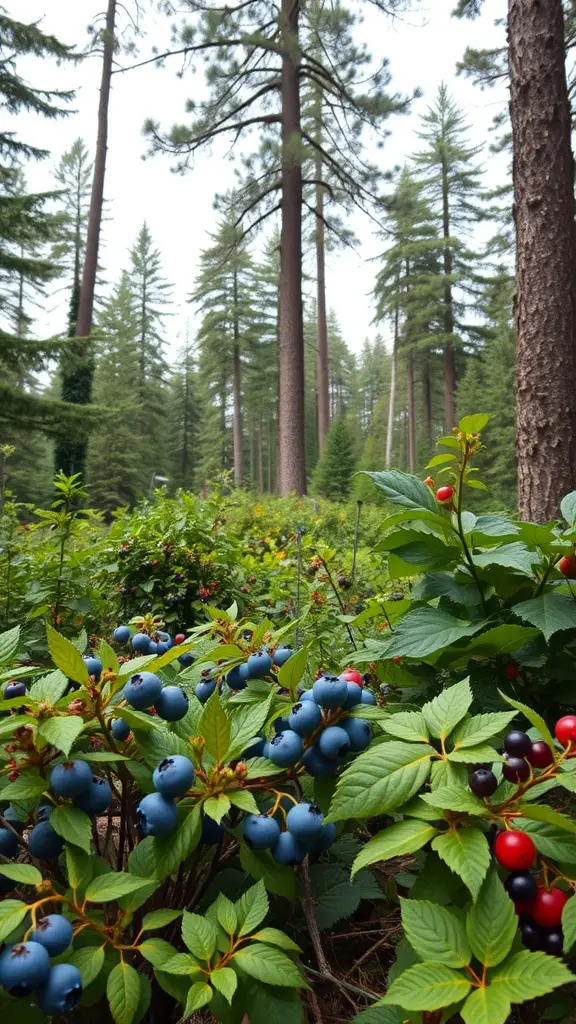
Forest gardens thrive with a variety of plants, and understory shrubs play a key role in this ecosystem. The image shows vibrant shrubs filled with blue and red berries, creating a lively foreground against tall, sturdy trees in the background.
These shrubs not only add beauty but also provide delicious fruit. Blueberries, raspberries, and other berry-producing plants can be great choices for your garden. They grow well in shaded areas, making them perfect for the understory.
Planting these fruitful shrubs encourages biodiversity. Birds and other wildlife will visit your garden, attracted by the berries. Plus, you’ll enjoy fresh fruit right from your yard! Consider mixing different varieties to extend the harvest season and enjoy a range of flavors.
Wildflower Meadow Edge

Creating a wildflower meadow edge is a delightful way to enhance the beauty of your garden. These vibrant flowers bring color and life to any outdoor space. The image showcases a stunning array of wildflowers in various shades, ranging from cheerful yellows to soft pinks and whites.
Wildflowers not only attract butterflies and bees but also promote biodiversity. Their natural growth patterns can create a relaxed, informal look. This type of garden edge is perfect for those who wish to blend their garden with the surrounding nature.
To start your wildflower meadow, consider choosing native species that thrive in your area. Planting a mix of flowers can ensure blooms throughout the growing season. Plus, they require less maintenance and are more resilient to pests.
Incorporating a meadow edge can also provide a lovely backdrop for other plants. The tall flowers can frame shorter plants beautifully, adding depth to your garden. Think of it as a living border that continually evolves with the seasons.
Edible Canopy Trees

Edible canopy trees can bring a new layer of beauty and utility to your forest garden. The image shows a serene garden path framed by tall trees, a lovely touch for any edible landscape. Picture yourself walking through lush greenery, with dappled sunlight filtering through the leaves.
Imagine planting trees that not only provide shade but also bear delicious fruits or nuts. Trees like pawpaw or mulberry can thrive in this environment. They can grow tall and create a lovely canopy while offering tasty treats for you and local wildlife.
Incorporating these trees into your design can create a productive and enjoyable space. You can mix them with other plants that thrive in the shade, maximizing your garden’s potential. Edible canopy trees are a smart choice for anyone looking to enhance their garden.
Wildlife-Friendly Habitats
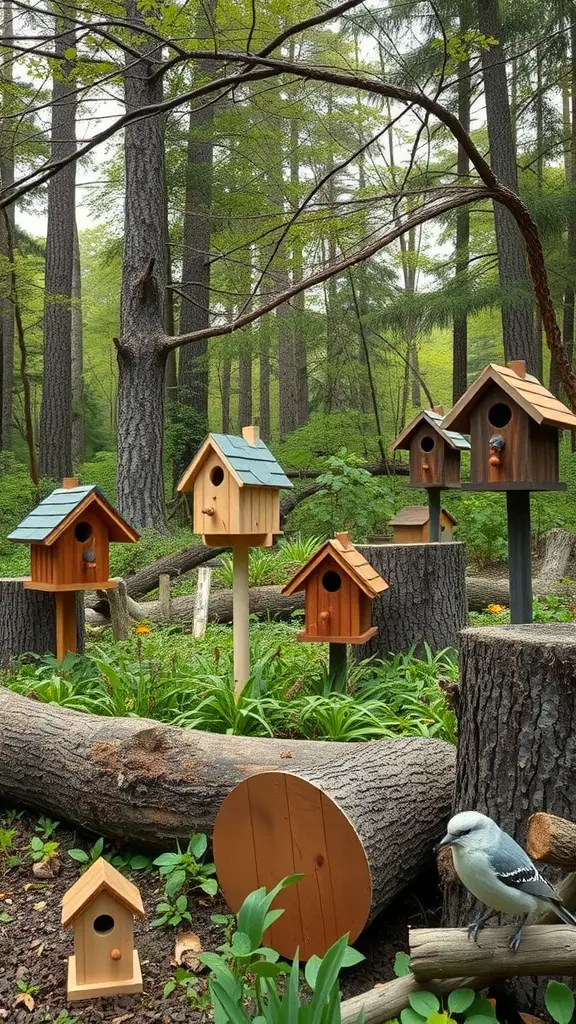
Creating a wildlife-friendly habitat in your forest garden is fun and beneficial. The image showcases a charming collection of birdhouses nestled among lush greenery and logs. These birdhouses offer safe spaces for birds, attracting them to your garden.
Planting native flowers and shrubs around these structures can enhance the environment. Flowers provide food for pollinators, while shrubs offer shelter and nesting spots. This combination encourages a diverse range of creatures, from birds to butterflies.
Another great idea is to incorporate logs and stones. They create natural hiding spots for small animals and insects. These elements not only beautify your space but also contribute to a balanced ecosystem.
Providing a water source is key too. A small pond or birdbath can keep your feathered friends hydrated. Observing wildlife brings joy and helps you connect with nature.
Layered Planting for Biodiversity
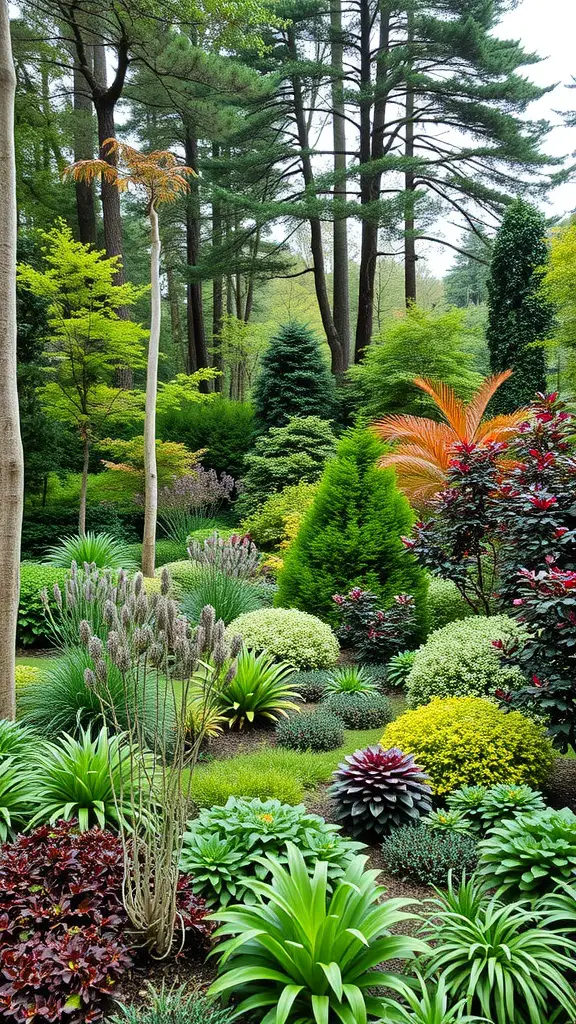
Layered planting is a fantastic way to create a lush, vibrant forest garden. The image reflects this concept beautifully, showcasing a variety of plants at different heights and textures. This harmonious arrangement not only looks appealing but also supports a diverse ecosystem.
In the picture, notice how the taller trees stand majestically, providing shade and support for understory plants. The varied foliage, from spiky to round, complements each other and creates a rich tapestry of greenery. This diversity attracts beneficial insects, birds, and other wildlife, enhancing the overall health of your garden.
Incorporating layers means considering ground cover, mid-level shrubs, and tall trees. This approach not only maximizes space but also ensures that each plant thrives in its ideal environment. Remember, a well-planned arrangement can turn your garden into a thriving habitat!
Herbaceous Perennials for Ground Cover
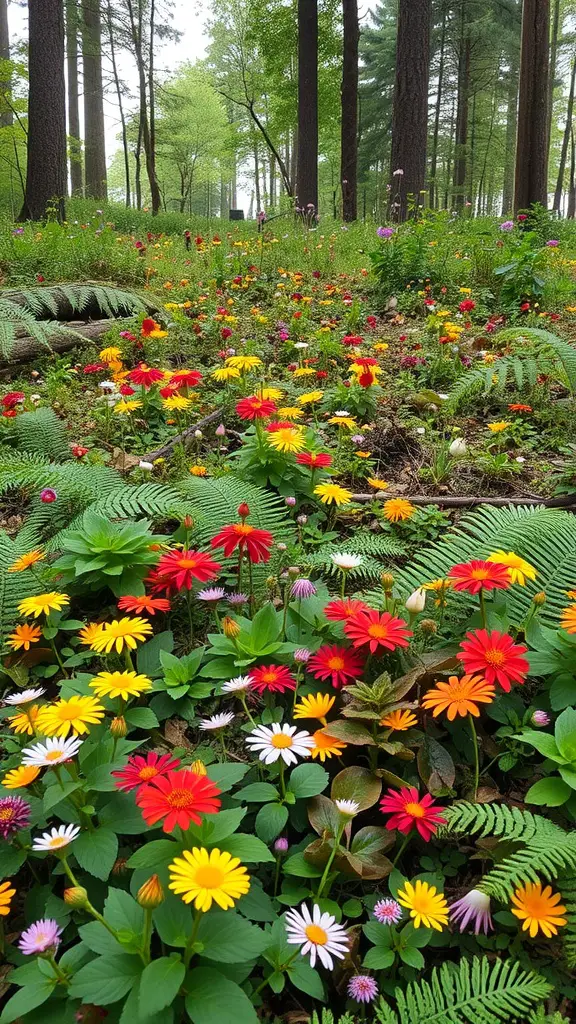
Creating a vibrant forest garden can be both fun and rewarding. One great way to enhance your space is by using herbaceous perennials for ground cover. These plants not only add color but also help prevent weeds and improve soil health.
The image showcases a beautiful array of colorful blooms amidst lush greenery. The mix of reds, yellows, and whites creates a cheerful scene, perfect for attracting pollinators. The ferns in the background add a lovely contrast and support the overall ecosystem.
Consider planting species like creeping thyme or ajuga. They spread easily and thrive in partial shade, making them ideal for forested areas. With the right selection, your garden can have a continuous display of flowers throughout the seasons.
Ground cover plants are low-maintenance and often drought-resistant, allowing you to enjoy a beautiful landscape without heavy upkeep. So, whether you want a pop of color or a serene green carpet, herbaceous perennials are a fantastic choice!
Sustainable Mulching Practices
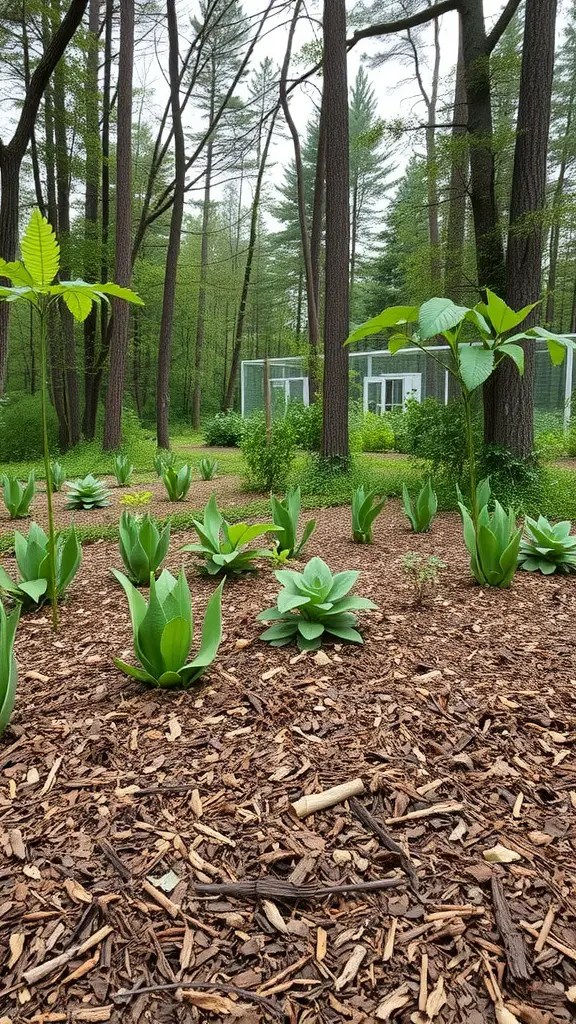
In this serene forest garden, you can see how mulching plays a key role in sustainable gardening. The rich brown mulch not only enhances the aesthetic but also aids in moisture retention. This is vital in creating a thriving ecosystem for the plants.
The lush greenery surrounding the area shows the benefits of using organic materials as mulch. It helps to suppress weeds, keeping the garden tidy and healthy. The lush plants, with their vibrant leaves, thrive with the nutrients from the mulch, creating a symbiotic relationship.
This image highlights the beauty of combining nature with thoughtful gardening practices. The forest backdrop adds tranquility, making it a perfect spot for a sustainable garden. Using mulching techniques like this can lead to a more productive and eco-friendly garden.
Seasonal Harvesting Areas

Seasonal harvesting areas in your forest garden can elevate your gardening experience. Picture a vibrant space filled with various plants, each offering a unique bounty at different times of the year.
The image showcases a lush garden with raised beds, brimming with leafy greens and vibrant tomatoes. The layout makes it easy to grow a variety of crops while utilizing the natural shade from surrounding trees.
Creating distinct zones for seasonal crops can help organize your garden and make harvesting simpler. By planning what to plant in each season, you can enjoy fresh produce year-round.
Consider introducing plants that thrive in different climates. For instance, leafy greens often grow well in cooler months, while tomatoes flourish in warmth. Rotate your crops to maintain soil health and productivity.
A seasonal harvesting area also encourages visitors to interact with nature. It becomes a place of learning, where you can share knowledge about gardening techniques and the benefits of seasonal eating.
Vertical Gardening Techniques

Vertical gardening is a smart way to maximize space while adding beauty to your forest garden. The image above captures a striking vertical garden structure surrounded by lush greenery. This setup not only saves ground space but also creates a stunning visual centerpiece.
Using planters stacked vertically allows you to grow a variety of plants, from herbs to flowers. The way each pot is arranged in this design demonstrates how you can create a layered look, making your garden feel more vibrant. By choosing plants that suit your climate and light conditions, you can make the most of this technique.
Such vertical structures can also provide a habitat for beneficial insects, enhancing the biodiversity of your garden. Plus, they can be a fun DIY project or a way to use unique materials you have at home. Vertical gardening techniques can fit any space, whether you have a tiny balcony or a larger yard, bringing a touch of nature closer to your living space.
Natural Pathways and Access Areas

Creating natural pathways in a forest garden helps blend the man-made with the wild. The image shows a beautiful winding stone path, surrounded by lush greenery. This pathway invites you to stroll through nature while enjoying the sights and sounds of the garden.
The path is lined with comfortable seating, perfect for relaxation or catching up with friends. These sitting areas encourage you to pause, enjoy a book, or simply take in the beauty around you. The combination of stones and plants keeps the path natural and unassuming, making it feel like a part of the landscape.
Incorporating access areas like this can transform a garden space. It not only improves accessibility but also creates a sense of exploration. You can design pathways that lead to hidden spots or open areas, making every visit feel unique.
Organic Pest Control Solutions

In a thriving forest garden, plants and trees create a beautiful scene, as shown in this vibrant image. The lush greenery and colorful flowers not only enhance the beauty of your space but also play a crucial role in natural pest control.
Using organic methods helps maintain a healthy ecosystem. Companion planting is an effective strategy; certain plants can repel pests or attract beneficial insects that keep harmful bugs at bay. For example, marigolds are known to deter nematodes, while herbs like basil can repel flies and mosquitoes.
Another method is to use natural predators. Ladybugs, lacewings, and birds can keep pest populations in check without harming your garden. You can attract these helpful creatures by planting a variety of flowers and providing water sources.
Lastly, homemade sprays using ingredients like garlic, dish soap, and hot peppers can deter pests without any harmful chemicals. These solutions are easy to make and safe for your plants and the environment.
Shade-Loving Plants
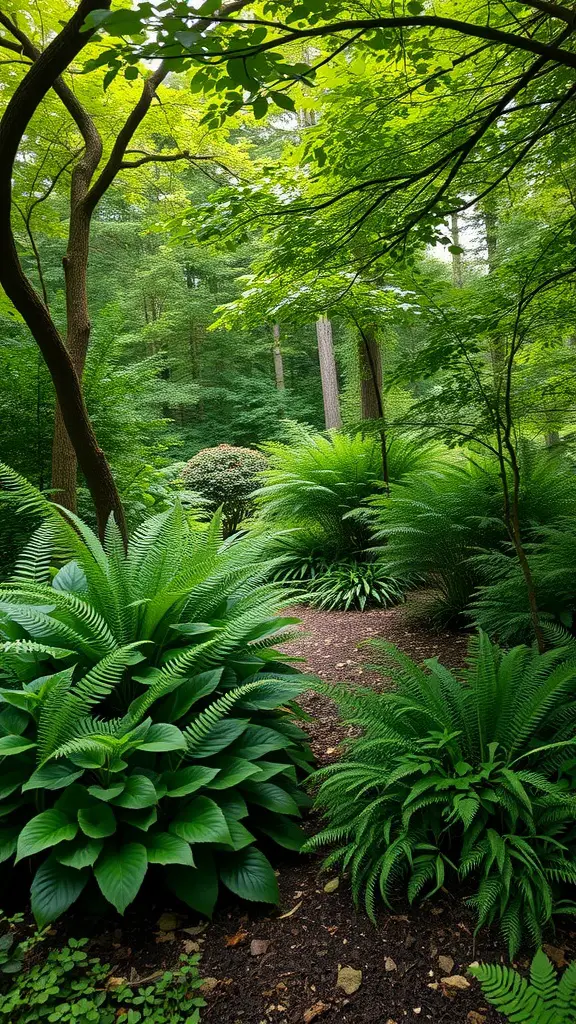
Creating a forest garden filled with shade-loving plants can transform a dull corner into a lush retreat. The image showcases an inviting space where vibrant ferns and leafy greens thrive under the shelter of tall trees. This natural setting demonstrates how such plants bring life to shaded areas.
Ferns are often the stars of a shady garden. Their fronds unfurl elegantly, adding texture and depth. Hostas are another popular choice. Their broad leaves come in various colors and sizes, making them perfect for filling empty spots. Pairing these plants with ground covers can help maintain soil moisture and prevent weeds.
Incorporating different layers in your garden can enhance its beauty. Tall plants like ferns can stand alongside shorter varieties, creating a natural flow. This layering not only looks great but also promotes biodiversity. Consider adding shade-loving flowering plants to bring in bursts of color. With the right combination, your forest garden can become a peaceful haven.
Companion Planting Schemes
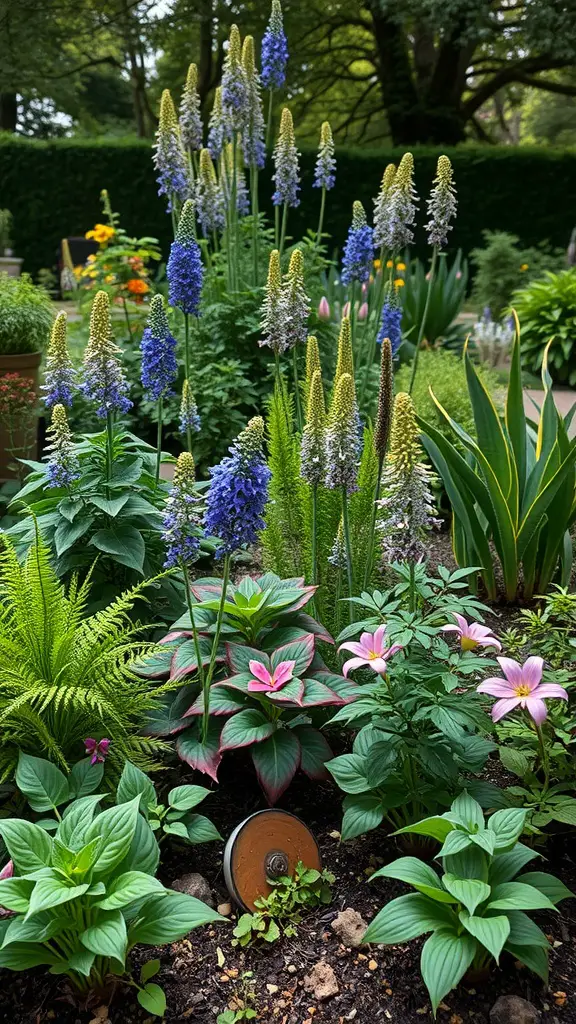
In a vibrant garden, different plants can thrive together in harmony. Companion planting is all about creating the right combinations to maximize growth and health. The image showcases a stunning array of flowers and foliage, illustrating the beauty of such schemes.
Notice the tall blue flowers that stand proudly, likely attracting pollinators. Surrounding them are lush green leaves and delicate pink blooms, creating a rich, colorful tapestry. These plants not only look good together, but they can also support each other in various ways.
For example, some plants may repel pests while others attract beneficial insects. This creates a balanced ecosystem right in your garden. You can start by pairing plants like marigolds with tomatoes, or basil with peppers, to see how they flourish side by side.
In this image, the mix of colors and shapes can inspire you to think creatively about your own companion planting schemes. A well-planned garden not only adds beauty to your space but also encourages a healthy plant community.



